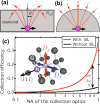Diamond nanophotonics
- PMID: 23365803
- PMCID: PMC3554578
- DOI: 10.3762/bjnano.3.100
Diamond nanophotonics
Abstract
We demonstrate the coupling of single color centers in diamond to plasmonic and dielectric photonic structures to realize novel nanophotonic devices. Nanometer spatial control in the creation of single color centers in diamond is achieved by implantation of nitrogen atoms through high-aspect-ratio channels in a mica mask. Enhanced broadband single-photon emission is demonstrated by coupling nitrogen-vacancy centers to plasmonic resonators, such as metallic nanoantennas. Improved photon-collection efficiency and directed emission is demonstrated by solid immersion lenses and micropillar cavities. Thereafter, the coupling of diamond nanocrystals to the guided modes of micropillar resonators is discussed along with experimental results. Finally, we present a gas-phase-doping approach to incorporate color centers based on nickel and tungsten, in situ into diamond using microwave-plasma-enhanced chemical vapor deposition. The fabrication of silicon-vacancy centers in nanodiamonds by microwave-plasma-enhanced chemical vapor deposition is discussed in addition.
Keywords: CVD diamond doping; NV center; diamond; nanophotonics; plasmonic resonator; solid immersion lens.
Figures


 , where c is a proportionality constant, P is the optical power and r∞ represents the maximum achievable resolution at infinite power, which is determined by technical limitations such as imperfections of the optical mode [6].
, where c is a proportionality constant, P is the optical power and r∞ represents the maximum achievable resolution at infinite power, which is determined by technical limitations such as imperfections of the optical mode [6].












References
-
- Pezzagna S, Rogalla D, Becker H-W, Jakobi I, Dolde F, Naydenov B, Wrachtrup J, Jelezko F, Trautmann C, Meijer J. Phys Status Solidi A. 2011;208:2017–2022. doi: 10.1002/pssa.201100455. - DOI
-
- Ziegler J F. The Stopping and Range of Ions in Matter. 2012 Available from: http://www.srim.org/
LinkOut - more resources
Full Text Sources
